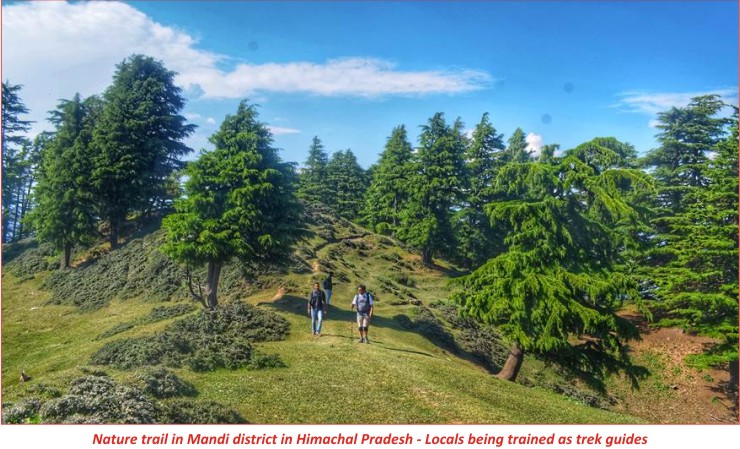|
Conserving Indigenous
Traditional Knowledge The evidence of human occupancy in the Himalayan region can be traced back to two million years ago. These mountains due to their inaccessible terrain have remained secluded from the influence of the plains for a long time and as a result hill communities have accumulated a lot of knowledge to sustain themselves in these geo-climatic conditions. For centuries, they have had a peaceful co-existence with nature, where ‘nature’ and ‘not man’ has been the guiding force. They have a plethora of knowledge related to tools and techniques for hunting & agriculture, eco-friendly architecture, ecological knowledge, environmental conservation, traditional medicine, food, crops, animal husbandry and others. This knowledge crucial for subsistence and survival has been passed from generation to generation orally or through traditions, practices, rituals, songs, stories and laws.1 Unfortunately, this rich base of Indigenous Traditional Knowledge (ITK) is being rapidly eroded under the forces of modernisation and external influences2. Eco tourism is a great way to preserve this ITK. There are hundreds of locations in Himachal Pradesh where unique cultures, practices and traditions still exist and can offer unique experiences to the tourists. However, the biggest challenge is the capacity of the local communities to manage and operate eco-tourism projects on their own. There has to be appropriate training and capacity building programmes to enable them to handle tourists, accounts, enterprises, marketing and promotions. The need of the hour is to develop a model where local people, who are guardians of different systems of Indigenous Traditional Knowledge, are involved and earn their livelihoods from eco-tourism projects to give them motivation to preserve and pass on that ITK to the next generation. It is important to engage the farmers, basket makers, weavers, folk singers and dancers, local medicine practitioners, masons, women and youth, who can provide different services and products to the visitors coming to their village. Currently Development Alternatives Group (DA) and Centre for Sustainable Development (CSD) are working on a project under National Mission on Himalayan Studies (NMHS). The main aim of this project is to promote nature conservation, livelihood generation and preserve the indigenous knowledge of hill communities. The project has identified 5 livelihoods (nature trail walks, traditional handicrafts, home stays, trek guides, local food and agriculture) which will alleviate the income of local communities and add value to the experience of the tourists.
Nature trails will enable the local communities to tap into their traditional knowledge on forests, birds, medicinal plants and cultural heritage of the villages and motivate the locals to conserve their ecology and earn by showcasing their natural beauty to the tourists. The Development Alternatives project team in Uttarakhand has developed three nature trails along with ‘Been There, Doon That’ team. Capacity building programmes have been conducted to train the locals in being nature guides. In Himachal Pradesh, nature trails have been developed within four village clusters near Parashar Lake - Thatta, Lagshal, Bhanuthi and Kalang in support with the Forest Department of Mandi, Centre for Sustainable Development and few local community people. The trails offers splendid views which are still undiscovered by mainstream tourists. The most delightful way to trek to unexplored regions of the Himalayas comes with a professional guide who is well equipped with immense knowledge on nature, culture, flora, fauna and heritage. Nature guide must ensure there is no waste is generated or left behind on the trail by the visitors. During the capacity building programme, the nature guides are sensitised about waste management to ensure the successful implementation of the initiative. All the eco-trails have been documented with the community’s support and facilitation. The trek route documentation entailed GPS mapping and recorded information on trek duration, key highlights from the trek, best season to travel, flora and fauna, terrain, difficulty level which have been included in a combined brochure for tourist and nature enthusiasts. Traditional handicrafts like shawls, mats, baskets etc are slowly vanishing as they are unable to compete with similar products made of synthetic materials which are cheaper, durable and more fancy. This project intends to market them to the tourists and in bigger markets to enhance the supply side. Home stays - The tourists will be staying in the home of the locals which are maintained and built with traditional materials. Trek guides will apprise the tourists about various flora and fauna of the area and how they are important for the local ecology. Traditional food uses various plants, herbs and shrubs which are available in different seasons and are very rich in nutrients like guchhi, lingad, karyale, fegdi. By offering these food items to tourists, the traditional knowledge is conserved, locals earn their livelihood and the tourists get an altogether different culinary experience. Agriculture is the mainstay of the Himalayan economy. Local agriculture produce like flour, rice, kodra, rajma, desi ghee and honey will be sold to the tourists. All these measures will attach a monetary value to the traditional indigenous knowledge and motivate the locals to conserve, practice and propagate their knowledge which otherwise might be lost in near future. Tapping into the local skills, traditional mountain culture and reviving the traditional indigenous knowledge is a definitive way forward for the Indian Himalayan Region. ■
References
Tanya Issar and Nikhil
Tiwary
|
